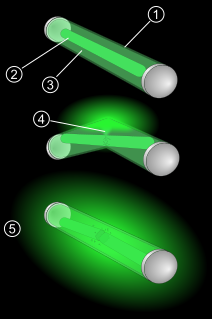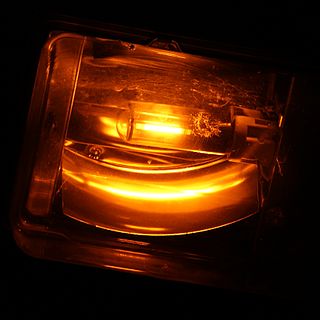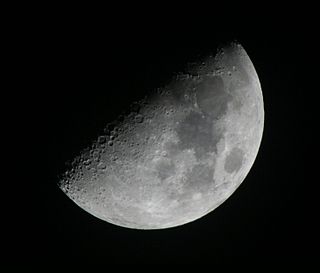This article has multiple issues. Please help improve it or discuss these issues on the talk page . (Learn how and when to remove these template messages) (Learn how and when to remove this template message)
|

A Flashflight is a flying disc designed to be used for night-time disc games between two or more individuals. [1] The Flashflight differs from traditional discs (including glow-in-the-dark models also intended for nocturnal usage) in that it has a completely enclosed single ultra-high brightness LED and fiber optics designed to distribute light from the center of the disc to the outer rim. The red light (630 nm wavelength) does not interfere with human night vision, and is visible from all disc angles because all disc surfaces are illuminated – the top deck glows, there is a radiant array on the concave underside, and there are nine bright dots on the perimeter of the rim.

Flying disc games are games played with discs, often called by the trademarked name Frisbees. Ultimate and disc golf are sports with substantial international followings.

Phosphorescence is a type of photoluminescence related to fluorescence. Unlike fluorescence, a phosphorescent material does not immediately re-emit the radiation it absorbs. The slower time scales of the re-emission are associated with "forbidden" energy state transitions in quantum mechanics. As these transitions occur very slowly in certain materials, absorbed radiation is re-emitted at a lower intensity for up to several hours after the original excitation.

In physics, the wavelength is the spatial period of a periodic wave—the distance over which the wave's shape repeats. It is thus the inverse of the spatial frequency. Wavelength is usually determined by considering the distance between consecutive corresponding points of the same phase, such as crests, troughs, or zero crossings and is a characteristic of both traveling waves and standing waves, as well as other spatial wave patterns. Wavelength is commonly designated by the Greek letter lambda (λ). The term wavelength is also sometimes applied to modulated waves, and to the sinusoidal envelopes of modulated waves or waves formed by interference of several sinusoids.
Designed in 2002 by University of Colorado at Boulder alumni Jeff Scott and Jerry Moore, the Flashflight (a trademarked brand name) is manufactured via injection molding, using a soft polyethylene. A standard lithium coin-cell battery (CR2430 3 volt or DL2430 3 v) powers the 185-gram, 10.75-inch-diameter (273 mm) disc.

A trademark, trade mark, or trade-mark is a recognizable sign, design, or expression which identifies products or services of a particular source from those of others, although trademarks used to identify services are usually called service marks. The trademark owner can be an individual, business organization, or any legal entity. A trademark may be located on a package, a label, a voucher, or on the product itself. For the sake of corporate identity, trademarks are often displayed on company buildings. It is legally recognized as a type of intellectual property.

Polyethylene or polythene (abbreviated PE; IUPAC name polyethene or poly(methylene)) is the most common plastic. As of 2017, over 100 million tonnes of polyethylene resins are produced annually, accounting for 34% of the total plastics market. Its primary use is in packaging (plastic bags, plastic films, geomembranes, containers including bottles, etc.). Many kinds of polyethylene are known, with most having the chemical formula (C2H4)n. PE is usually a mixture of similar polymers of ethylene with various values of n. Polyethylene is a thermoplastic; however, it can become a thermoset plastic when modified (such as cross-linked polyethylene).

Lithium batteries are primary batteries that have metallic lithium as an anode. These types of batteries are also referred to as lithium-metal batteries.
Other Flashflight models include the smaller and softer polyurethane "Mini" and "Junior" versions marketed for children and disc-trained dogs.

Polyurethane is a polymer composed of organic units joined by carbamate (urethane) links. While most polyurethanes are thermosetting polymers that do not melt when heated, thermoplastic polyurethanes are also available.
Marketing is the study and management of exchange relationships. Marketing is the business process of creating relationships with and satisfying customers. With its focus on the customer, marketing is one of the premier components of business management.

Disc dog is a dog sport. In disc dog competitions, dogs and their human flying disc throwers compete in events such as distance catching and somewhat choreographed freestyle catching. The sport celebrates the bond between handler and dog, by allowing them to work together. The term "disc" is preferred because "Frisbee" is a trademark for a brand of flying disc.

















